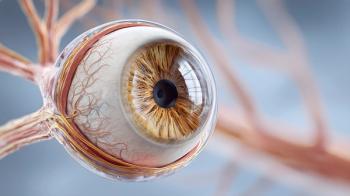
Can Ocular Biomarkers Be Used to Diagnose Alzheimer’s Disease?
In an umbrella review — a review of reviews — investigators found that so far, studies of ocular biomarkers to diagnose Alzheimer’s disease had important limitations. Longitudinal studies that use artificial intelligence could perhaps identify ocular biomarkers, the researchers suggest.
Research of ocular biomarkers for diagnosing Alzheimer’s disease are often poorly reported and of limited clinical significance, according to a recent umbrella
The retina is part of the central nervous system with direct connection with areas of the brain, and investigators have suggested that measurements currently used in ophthalmology could hold potential for assessing dementia.
Alzheimer’s disease can result in changes in the eye, including abnormal pupillary reaction, decreased contrast sensitivity, loss of retinal ganglion cells and the retinal nerve fiber layer,
In a related
But the takeaway from this umbrella analysis, cautioned Barrett-Young, is that measures of retinal parameters may not be as effective at distinguishing people with mild cognitive disease or Alzheimer’s disease. “More longitudinal studies of changes across time are needed to understand whether dynamic processes, such as retinal thinning, are better predictors of preclinical AD than static measures, such as retinal thickness,” she wrote. “Greater consistency in diagnostic criteria across studies would increase the validity of meta- analyses, providing stronger evidence on the potential of clinical importance of ocular biomarkers for early AD screening.”
Investigators in the umbrella review, led by Eliana Costanzo, M.D., of IRCCS-Fondazione Bietti in Rome, searched MEDLINE, Embase, and PsycINFO from January 2000 to November 2021. They included reviews if they investigated the diagnostic accuracy of ocular biomarkers to detect Alzheimer’s disease. Primary measures of effect were sensitivity, specificity, and area under the curve (AUC), which would indicate a number related to the data. Investigators in this analysis considered 0.70 as the threshold between poor and acceptable diagnostic accuracy and 0.80 as the threshold between acceptable and excellent accuracy.
Investigators included 14 systematic reviews, which were published between 2016 and 2021 and included between five and 126 studies. The biomarkers assessed included optical coherence tomography to assess retinal nerve fiber layer, optical coherence tomography angiography to assess foveal avascular zone area,
Optical coherence tomography is technique for retinal measuring. Changes in the thickness of the retinal nerve fiber layer can impact sight have been seen patients with Alzheimer’s. Optical coherence tomography angiography assesses foveal avascular zone area, which is the region within the retina that doesn’t have blood vessels. Patients with Alzheimer’s have changes in the area surrounding the foveal avascular zone.
The investigators in this review found that mean peripapillary retinal nerve fiber layer thickness was reported in the largest number of studies in three systematic reviews, with an area under the curve of 0.70 in the most extensive review (38 studies). Five reviews reported on optical coherence tomography angiography to assess foveal avascular zone area, which is the region within the retina that doesn’t have blood vessels. Investigators determined an area under the curve of 0.73. Saccadic eye movements were explored in two systematic reviews with meta-analysis that reported significant alterations in patients with Alzheimer’s disease, with an area under the curve of 0.79.
The modest diagnostic performance of optical coherence tomography and optical coherence tomography angiography does not mean these have no use in dementia investigation, investigators said.
“Longitudinal studies on AD (Alzheimer's dissease) and MCI (mild cognitive impairment) development might result in better diagnostic accuracy compared with cross-sectional detection,” they wrote. “Even biomarkers with weak diagnostic performance could be used in artificial intelligence-based algorithms for case finding or prediction, provided that they contribute independently from other variables.”
A limitation of their review is that it did not assess study overlap between systematic reviews and did not attempt a meta-analysis of original studies. Investigators suggested that future longitudinal studies should investigate whether changes in optical coherence tomography and optical coherence tomography angiography measurements over time can yield accurate predictions of Alzheimer’s disease onset.
Newsletter
Get the latest industry news, event updates, and more from Managed healthcare Executive.


















































